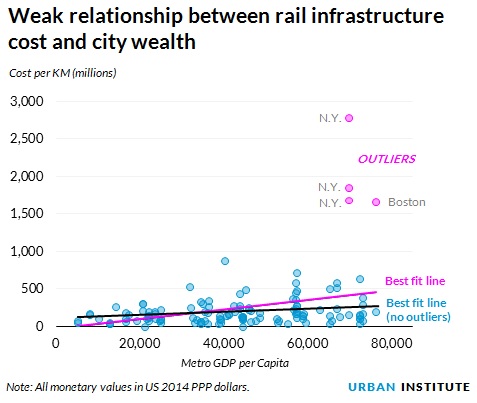
This post originally appeared on RealClearPolicy.com.
With the nation’s Highway Trust Fund projected to go broke at the end of this summer and Congress unable to agree on a permanent fix, it is an opportune time to reexamine the so-called consensus on infrastructure funding—that we need more of it and now. Focusing on how much we spend leaves out a more important question: how much infrastructure we get for our money.
Put bluntly: the costs of US infrastructure are too damn high.
How high? It’s not easy to find comprehensive data on infrastructure costs around the globe. But with help from various government and business websites as well as some very busy bloggers, we pulled together data on 144 planned and finished rail projects across 44 countries.
We can’t know whether these data are truly representative of all rail projects recently built or currently underway. However, we do know whether projects feature tunnels, stations, or elevated tracks, so we can be fairly certain we are comparing apples with apples.
America is #1 (in expensive rail projects)
It turns out that, at least in our sample, the United States is home to the four most pricey per kilometer rail and majority-tunnel projects in the world.
Towering among giants is New York City’s East Side Access project to join the Long Island Rail Road and Grand Central Terminal at cost of $3 billion per kilometer by the time it’s finished in 2023. Beyond East Side Access, New York has two more projects (the Second Avenue Subway and No. 7 Line extensions) in the $1.5 billion to $2 billion per-kilometer range.
To put these numbers in global perspective, New York’s Second Avenue Subway will cost roughly eight times more than Tokyo’s Koto Waterfront line and 36 times more than Madrid’s Metrosur tunnels on a per-kilometer, purchasing power parity (PPP) basis.
But this is not strictly a New York problem. Outside of New York, there are three more US projects in the top 12: Boston’s proposed Red-Blue Line Connector, San Francisco’s Central Subway, and Los Angeles’s Westside Subway Extension.
Why is US rail so expensive?
An obvious answer is that land costs are higher in the United States, especially in built up cities like New York and Boston. But can US land costs really be that much more expensive than those in other wealthy, dense cities such as Paris? Or Tokyo?
Construction costs don’t explain the gap either. Take Paris’s Métro Line 4 extension Phase 1, which came in at just PPP $193 million per kilometer, despite passing underneath seven Métro lines, sewers, and four underground carparks, plus over two regional RER lines.
What about labor costs? Critics love to hate the Davis-Bacon law and other rail-specific labor regulations. But the following chart shows only a weak relationship between project cost and metro-area GDP, a rough proxy for wages, especially if we remove the top four projects in New York and Boston. And presumably higher wages also have something to do with higher worker productivity.

Beyond labor laws, several US regulations (Buy America provisions, safety requirements beyond international standards) affect the cost of rolling stock and other operating expenses. But many of these laws do not apply directly to construction. And for regulations to explain US costs, American laws would have to be tougher than in Europe where trade unions are much more powerful. (France, anyone?)
People also point fingers at the decentralization of transportation planning and funding in this country. But, according to IMF data, the United States is only slightly more fiscally decentralized than countries with much cheaper rail infrastructure, such as Japan. And heavily centralized countries like the United Kingdom often have very high rail construction costs.
Some possible explanations
Many of the world’s most expensive projects are in the United Kingdom, Australia, and New Zealand, which, like the United States, have common-law systems. So it might be that common-law systems provide legal protections for property owners—allowing more lawsuits over noise, smoke, and other nuisances as well as limits on eminent domain—that increase costs by forcing the government to pay off opponents or to locate projects inefficiently to avoid angering property owners. But some non-common-law countries, like Germany, also have strong legal protections for property holders yet low rail construction costs.
Is it electoral politics? The United States and many Commonwealth countries elect leaders by district rather than party-based proportional representation. Districted elections – at the national, state, or local level – may lead to inefficient projects as legislators try to bring pork home to their constituents or use “aldermanic privilege” to block transit from going through their districts, increasing costs.
Political fragmentation may also be a culprit. Rail projects often have to run through many localities and states. Local governments frequently have difficulty contracting with one another, which can inflate construction costs by encouraging duplication rather than sharing resources.
A common solution to the problem of inter-local contracting is creating regional bodies, but these entities have their own problems—particularly in terms of accountability.
Why does infrastructure cost so much in the United States? We don’t know yet. But it’s worth realizing that costly mega-projects make people distrustful that good projects will come to the fore. Figuring out why costs are so high may be crucial not only to bringing those costs down, but to getting a real consensus on infrastructure and a reliable source of funds for the nation’s roads, bridges, and transit.
Tune in and subscribe today.
The Urban Institute podcast, Evidence in Action, inspires changemakers to lead with evidence and act with equity. Cohosted by Urban President Sarah Rosen Wartell and Executive Vice President Kimberlyn Leary, every episode features in-depth discussions with experts and leaders on topics ranging from how to advance equity, to designing innovative solutions that achieve community impact, to what it means to practice evidence-based leadership.